
The A-word.
It's the bane of cinephiles, everywhere.
That book you love; the comic you remember; the show you used to watch; the game you lost an entire summer playing? Oh, someone's adapted it and it's getting made into a movie! Whether a cause for pre-emptive celebration or foreboding caution, it leads to only one thing: expectation. And expectation is the death of the 'clean' movie-viewing experience; no matter how closely the film sticks to its source material, or how much it tries to distance itself, it will be faced with the hurdle of comparison.
And while the movie industry loves the pre-built marketing buzz of 'now a major motion picture!', they loathe the comparative references which will be made from the first review onwards. Because many punters will expect to get exactly the same reaction from a completely different medium, to a story they already know. And therein lies the problem.
In this monthly series, we'll look back at some of the most respected and best-loved properties which have made the perilous journey to the big screen; often with some controversy, and almost always with far too much hype. This isn't so much a review of the films themselves, more an appraisal of their suitability as an adaptation.

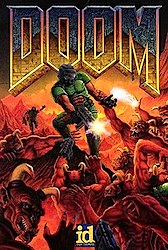 Doom (DOS / SNES)
Doom (DOS / SNES)
ID Software (1993)
Onwards and upwards; consoles are out, computers are where it's at now, grandad! The mid 90s saw game developers begin to properly harness the power of machines which had previously been used primarily as office tools. And while the advent of the Windows operating system made these more accessible, early games were still in good old DOS*1. The console-format wasn't dumped for good, obviously, and would be taken to the next level with Sony's Playstation, but the boom in PC gaming coincided (not that it was a coincidence) with the growth of domestic internet connections. Not only could titles be shared down a phone line (!), but programmers could distribute their own levels, upgrades and amendments ('mods') via the same method. And we'd only ever dreamed of remote multiplayer matches before. All of a sudden, we were living in the future. All that was needed was the right game to seize the possibilities…
Back in the late 80s, we'd had Freescape, an engine which allowed players to wander around three-dimensional environments, solving puzzles and the like. Technically impressive (given the hardware limitations of the Spectrum/Amstrad/Commodore generation), but sedate. Shortly after came the first flurry around virtual reality, in which the non-gaming civilian populace suddenly became aware of how immersive computer software could be. Again, fine, but it wasn't really accessible to home-tech users and something was missing for those of us who'd already been playing in other worlds for years. And that something was Shooting People In The Face™. Hard.
And so, back to living in the future. The memories of your first job. Sitting in the back-room of a high street print-shop after hours with a couple of colleagues and some beers from the offy next door, taking turns on the one solitary Windows 3.11 computer, skulking round the corridors of a military base on the moons of Mars and shooting imps and demons*2, letting up only when it was time to leg it for the last train home. Okay, they're memories of my first job, although I don't think I'm entirely alone in recollections like those.
All of this is idealistic nostalgia, of course. How does classic Doom actually hold up in 2017? Well, once we're installed with full functionality*3, pretty bloody well I'm happy to say. Sure, the game is pixelly in its visuals and basic in its mechanics, but it runs with a smoothness that was almost unheard of in 1993. Much like last month's Street Fighter II, the key thing about Doom is that the backstory is essentially irrelevant*4. Some stuff about being the last surviving human on a military base on Phobos, one of the moons of Mars, holding off hordes of monsters emerging from a portal to Hell. Scenes.
But this is all in the manual. There's no in-game catchup, no cut-scenes or cinematics, just one nameless space-marine ploughing through levels against increasingly tough foes with increasingly ridiculous weaponry. All the player actually needs to know is how the movement, firearms and switch-systems work; find the exit to the next level, kill anything which gets in your way. That's it. The door/key and switch combinations present some basic puzzle-solving, but if a player makes a point of clearing each room as they come across it, the game more or less solves itself. Also similar to last month's entry, Doom wasn't the first game of its kind, but it quickly became the most popular, the most iconic and the benchmark by which all others were measured*5.
1995 saw the release of Doom on the Super Nintendo Entertainment System*6, one of the last titles for a console on its wind-down and converted for the cartridge by Ocean Software. It's a noble effort. The smoothness of movement around the maps is maintained by reducing the play-area on the screen substantially, and this is even blockier than its DOS forbear. Movement is aided by the controller's L and R buttons becoming strafe-directions, but these can't be employed at the same time as turning so there's very little 'sliding into a room and letting rip with the chain gun'. Speaking of which, collision detection is absolutely atrocious here. That's handy if you're shooting into a crowd of zombies as they'll be picked off one at a time with barely an aiming-action from yourself. It's less handy if you're in the room with more than one adversary, since you start being injured as soon as they're there, irrespective of distance or line-of-sight. Surrounded by the hordes of Hell? Forget it. It's this element, unfortunately, which makes the SNES port barely playable. In fact I'll go further - if you're not familiar with Doom at all - the maps, the enemies, the wanting to actually see the thing which is spanging ten health-points off you every three seconds - the SNES port will be unplayable*7. I love that this version of Doom exists. I'm even more glad that it's not the only one I've got.
But the bottom line; Doom's still got it where it counts.
If you can live with the pixels...

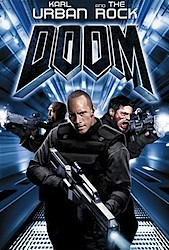 Doom
Doom
Andrzej Bartkowiak (2005)
And so, the million-dollar question*8 rears its ugly head once again: how do you make a movie from a game with no narrative?
Well, there are going to be changes. The portal between Phobos and Hell becomes one from Mars to Earth, and the zombies and imps aren't the manifestations of Hades, but the product of Evil Nasty Scientists Meddling With Things They Don't Understand™. The last surviving marine treading the line between carnage and insanity becomes a squadron, called in to investigate a distress-call from the UAC research-base on Mars (ie, not its moons, Phobos or Deimos), and there's an awful lot of human interaction for a property which was essentially about isolation and agoraphobia.
Naturally, the team we're following all have their own distinct personality-traits, but these are amplified to the point of psych-defects, where not a single one of them would be selected for active duty in any armed unit. And while we're on, despite an impressive array of firearms, none of the team are wearing any protective headgear or night-vision equipment to go padding around darkened corridors in a locked-down military base. Although you get the impression that troops like these wouldn't bother with either anyway. But since the film follows the marines as a group-unit, it stands to reason that there's not really a central character to root for (which is the very opposite of the game-mechanics). And since these characters all inherently ittitating, it really doesn't matter when they start being picked off by the undead remnants of UAC office staff.
The brawn-end of the flick is headed up by Dwayne Johnson (at the time, still being billed as The Rock) and Karl Urban, with Rosamund Pike picking up the 'brainy scientist' reins as Karl's estranged sister. A bunch of familiar faces with ludicrous squad-nicknames make up the numbers, and the rest is autopilot. There are still nods to the game with weapon-types, but everything else about this suggests a screenplay that was sitting in a cupboard, hastily re-tooled when Universal called with the news that they'd got the license from ID Software. It often feels like a mid-80s action movie that's been made with a mid-00s budget and technology. In fact it's probably not unfair to say that screenwriters Dave Callaham and Wesley Strick owe so much to Aliens and Predator that they've had to take out a loan from Resident Evil just to keep up the repayments. The film's self-congratulatory First Person Shooter centrepiece sequence doesn't happen until an hour and a half in, and even then it's only five minutes long and executed at an oddly sluggish pace.
The movie is nowhere near as awful as the Rotten Tomatoes score would suggest, but expectation killed its chances faster than the BFG-9000. If anything, Doom feels more like a prequel or lead-in for the game, albeit one which dismantles the plot before the main event. The film certainly plays like a bunch of the stitched-together cutscenes which the first two games never had, at any rate, and while it makes a decent screen-adaptation of the squad-based shooters from later years, it's just not Doom. Yet at the same time, it's hard to imagine a viable screenplay that would be…*9
Although hats off to the bit where the marines are denoting areas they've cleared with fluorescent marker on the doorways. I like the thought of a bunch of trained killers being subject to an impromptu stationery audit…

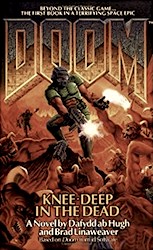 Doom: Knee Deep In The Dead
Doom: Knee Deep In The Dead
Dafydd ab Hugh & Brad Linaweaver (1995)
Firstly, a disclaimer: I have read this novel before, some time around 2005. And while that puts it before the beginning of this blog, an ongoing exercise which has trained my brain to think more critically about the content presented to it, I have to say that I recalled it as being passable tie-in fiction based on a game with no real story. With that brief in mind, and much like the film up there, the authors have pretty much carte blanche to do as they please, so how could that go wrong, yeah? Reader, I have to tell you that the Doom novel is fucking awful. Things don't get off to a great start when you realise this aspires to be a hard-nosed military thriller, seemingly written by people whose sole experience of the armed forces comes from Ross Kemp documentaries and an unhealthily thumbed collection of Andy McNab novels.
With our central hero ('Flynn Taggart', a name which couldn't have much more testosterone if his middle name was 'Bollocks') being a grizzled marine from Florida who finds himself shipped to Mars while on an insubordination charge (of course he fucking does), the book is obviously deliberate in how over-the-top it is. Unfortunately, I can't work out if it's deliberate in how bad it is. When it's not all muscles, guns and decapitating demons, our hero is also given to musing about the opposite sex, and coming off like Alan Partridge in the process…
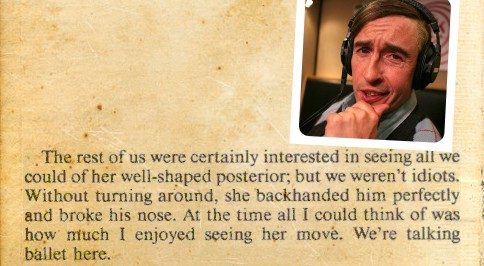
He's got an eye for the girls…
…but a couple of pages later once the gore began to kick in, it occurred to me that this is textbook Garth Marenghi, and that's the inner-monologue voice which stuck thereafter…
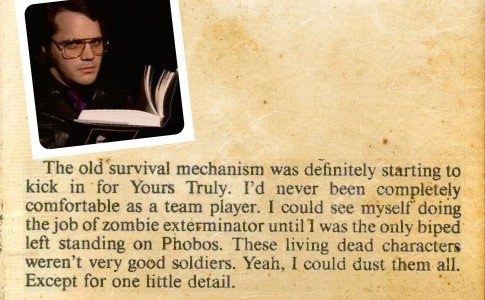
…and an eye for the GUNS!
There are human characters besides Flynn and his lust-object colleague Arlene Sanders of course, but everyone somehow manages to be less likeable than the invading hordes of the netherworld. Naturally, being A Guys' Book for The Guys to read like The Guys would, the authors (and they're each authors of other stuff as well, mind - it's not like they knocked this one out and were never published again) have added dashes of wry humour to break the otherwise inescapable tension of their tome…

And reader, neither will you...
The first undead soldier our hero runs into when he's on Phobos is called William Gates. Yes, Bill Gates. I think this is what passed for hilarity in 1995. And it's not just the corny nature of the asides which caused me to recoil in horror, as we get to play Spot The Grammatical Error, too…

Proof-readers? Where we're going we don't need… 'proof-readers'.
This, as well as glaring internal inconsistencies...
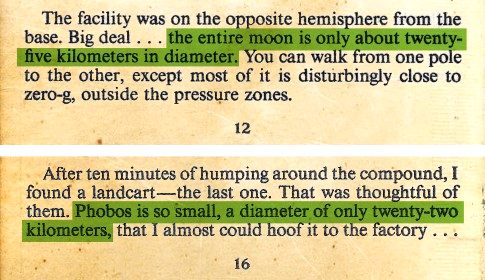
Help! Come quickly! The moon is SHRINKING!
I guess that's what happens when you have two authors who don't have each others' phone number. That said, Phobos is actually an irregular shape, which could allow for the confusion. Except that I don't expect the novel to be an encyclopaedia. Make it any fucking size you like guys, just choose one and stick to it. That's what you're being paid for. But better than all of the above is this absolute beauty…
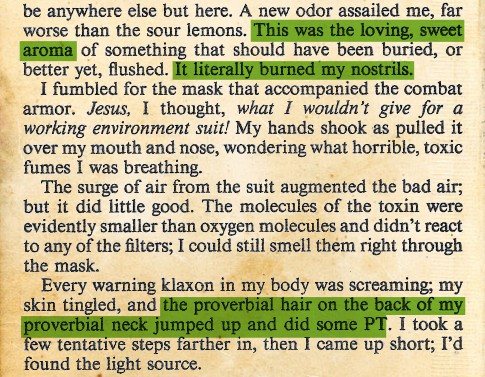
For an author to not know the definition of 'literally' is unfortunate. To demonstrate one's corresponding unfamiliarity with 'proverbial' ON THE SAME PAGE is catastrophic…
I've read a few game tie-in novels before, none of which have been as inept as this. Reader, I do not mind admitting that I gave up on Doom: Knee Deep In The Dead before finishing it*10. A bad movie takes the same amount of time to watch as a good one. A bad book is like slow-motion self-flagellation for the brain. Ridiculous.
There are, apparently, three more of these novels. Sweet Christ…

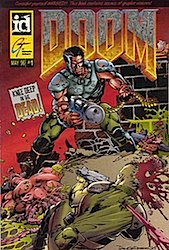 Doom: Knee Deep In The Dead!
Doom: Knee Deep In The Dead!
Steve Behling & Michael Stewart (1996)
Well, it's shorter. If the Doom comic has one thing going for it, it's that the Doom comic is shorter than the Doom novel. I mean, it makes less sense to the point where it's not even trying to be coherent, but the whole thing will only take fifteen minutes off your life. If you read it twice. The opening page credits-panel bears the words "Vol.1 Issue 1" in a way which suggests that writers Steve Behling and Michael Stewart have no comparative references for the words 'optimism', 'hubris' or 'delusion'. No further issues were produced (and if anything, this went on to become something of a collector's item, albeit for the wrong reasons). The credits-page also claims that the publication has been edited. Although given the fifteen pages which follow, one dreads to think what manerial didn't make the printing press…
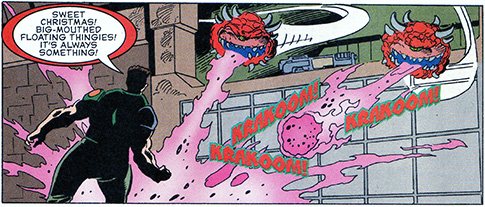
Reader, this dialogue was actually published...
The story is still on Phobos. Well, I say 'story'. The events of this comic take place on Phobos. Well, I say 'Phobos'. The events of this comic take place in an industrial/military complex filled with the bad guys from Doom and the guy in a green combat suit running around taking them all out. Well I say 'comic'. It's sixteen pages long, whereas standard-format is twenty-two. Comics are a primarily visual medium, but they are supposed to be about visual storytelling. Leaping in medias res with not so much as a location-card, Knee Deep InThe Dead! is a series of barely connected, sketchily drawn panels, narrated by a character with no character and by writers who confuse word-count with meaning. If the novel tries to create a story out of nothing, the comic shovels in dialogue where none should exist at all…

I'm glad this panel has so many words, because I have none…
With such a slight pagecount, it's almost admirable that the writers don't try to create a plot where none exists, but to think that two people are responsible for the babbling which fills the vacuum as a result is incredible. You'd think that the art would take centre stage in a comic-adaptation of an iconic game. Ah. Tom Grindberg's*11 loose,sketchy style is heavy on the ink meaning all that's needed for the colours is mostly flat blocks behind the linework. The end result looks very cheap and with a final product like this it's hard to know if that's aesthetically intentional or just budget constraints. Although credit where it's due, Tom clearly enjoys drawing the monsters from Doom. Even if he's as slapdash at that as he is everything else.

Our protagonist appears to be from Newcastle, which could explain a lot of you think of this as Biffa Bacon on absinthe, viagra and mescaline…
The Doom comic is every bit as bad as the Doom novel, although mercifully far more brief. It's perhaps telling that the live-action movie spinoff wouldn't see the light of day until nine years after this.
If you remain to be convinced, you can read the comic here. You can say you were sent, but you can't say you weren't warned…*12

Uh-huh.
It is the best thing.

It's better than you've heard, but not as good as you'd hope.

Game, definitely.
Movie, probably.
Comic, not likely.
Novel, not at all.

Not in the game and not in the movie that I heard.

Level 1: The film's got General Antoc Merrick in it.
*1 Note for younger readers: since a significant amount of processing power was allocated to running the operating system alone on those machines, not leaving a lot for the dynamic demands of full-screen slaughter, we had to exit Windows completely and launch the game by typing a command line. It sounds prehistoric now, but bear in mind that when we switched the computer on in the morning, we also had to start Windows with a similar typed command. You kids don't know how lucky you are with your PinPods and your PlayBox 4's… [ BACK ]
*2 In The Face™. Hard. [ BACK ]
*3 Note for non-Steam using nostalgists (or readers landing here from a Google search): If you happen to be loading up the game from the Doom Collectors Edition CD, you'll need to create a DPLAY.DLL file after installation, and you'll have the Doom95.exe executable, which doesn't include mouse-support in Windows XP or higher. While it's technically possible to play the game without using the mouse to look left and right as you strafe with the keys, that's not a fun experience. You can download David Kay's Ultimate Doom mouse-installer at the link on this page, and it's an absolute godsend. It should also be noted that I'm including this link for my own future reference, since I'll probably have lost the link by then. Truth be told, I lost the link between installing the game and drafting this paragraph... [ BACK ]
*4 And all the more irrelevant because of how much sense it doesn't make. Think for example, how impractical this military base would have been before the portal opened and the aliens invaded.
"How do I get though this door, Terry?"
"Oh, the unlock-switch is three quarters of a mile away, down one of those similar-looking corridors there…"
"Standard…"
[ BACK ]
*5 The same colleague who installed Doom on the works-computer also procured, at a later date, a mod which swapped out all the bad guys for Stormtroopers and Imperial Officers from Star Wars. You can imagine my excitement. You can also imagine how far apart my mind was later blown by playing Lucasarts own bandwagon-jumper, Dark Forces, to this day one of my favourite Star Wars games. [ BACK ]
*6 Which, much like Mario Bros and Street Fighter II, I happen to own, hence my appraisal of it for Adaptation. And yes, in scheduling the gaming-section of this series, I did essentially just open my drawer of SNES games and go "right, which ones of these have been made into movies?". Although I bought the PC version of Doom from off of Ebay. Come on, it's not like I put no effort into this… [ BACK ]
*7 I managed to get to the end of Command Control (level 4 of Knee Deep In The Dead) before sacking the whole thing off and going back to the PC version. Although I've never been known for my patience as a gamer... [ BACK ]
*8 Well, in the case of the Doom movie it's more of a $60 million dollar question, since that was its budget. But hey, at least it made back $56m of that, right..? [ BACK ]
*9 I, for one, cannot imagine for a second why Universal decided not to create an 18-rated gorefest full of Satanic imagery and literal, non-rational demons. It's not like they completely nerfed the project by making it a 15-cert starring an ex-wrestler, they just removed the uncompromising cornerstone of what made the original so entertaining… [ BACK ]
*10 And I did not do this lightly, having only ever abandoned two books before (Alan Dean Foster's 1979 Alien novelisation - the book transforming a masterclass in cinematic tension into an almost indescribably boring shopping-list of events, and James Frey's A Million Little Pieces - a borderline illiterate and attention-seeking memoir from a confessed fantasist and liar). That said, since I've read the Doom novel to completion in the past, I suppose it doesn't really count as part of that list after all… [ BACK ]
*11 Tom Grindberg is his real name, by the way, not some amusing gory-pseudonym adopted especially for the comic (he's listed as Tom "Gallows" Grindberg on the credits-page). He's actually a proper comic-book artist. He's worked for Marvel and DC and 2000AD and everything. Without having looked into his wider canon, I'm going to assume the Doom project was a pad he kept down beside the toilet. [ BACK ]
*12 And again, thanks for reading all these. Twelve footnotes may seem excessive, but this has been a long post. Although if it's any consolation, nowhere near as long as the 'research' which went into writing it. And look on the bright side: This is the final Adaptation, so you won't have to wade through any more pieces this unwieldy. Well, probably… [ BACK ]
DISCLAIMERS:
• ^^^ That's dry, British humour, and most likely sarcasm or facetiousness.
• Yen's blog contains harsh language and even harsher notions of propriety. Reader discretion is advised.
• This is a personal blog. The views and opinions expressed here represent my own thoughts (at the time of writing) and not those of the people, institutions or organisations that I may or may not be related with unless stated explicitly.

No comments:
Post a Comment